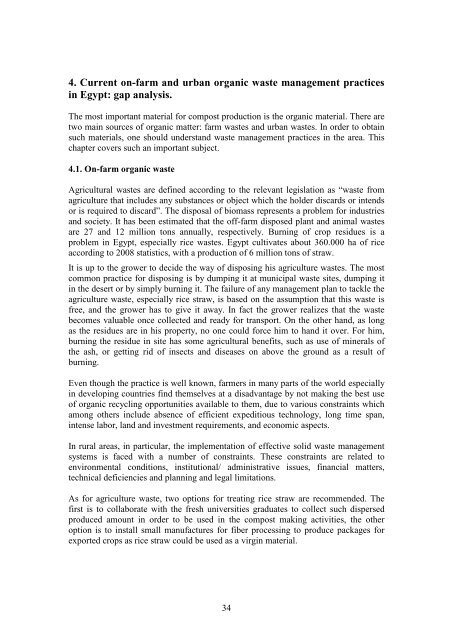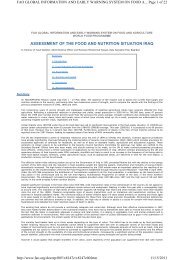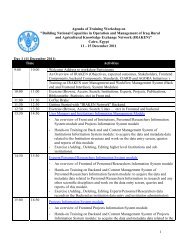Vermiculture in Egypt: - FAO - Regional Office for the Near East and
Vermiculture in Egypt: - FAO - Regional Office for the Near East and
Vermiculture in Egypt: - FAO - Regional Office for the Near East and
You also want an ePaper? Increase the reach of your titles
YUMPU automatically turns print PDFs into web optimized ePapers that Google loves.
4. Current on-farm <strong>and</strong> urban organic waste management practices<br />
<strong>in</strong> <strong>Egypt</strong>: gap analysis.<br />
The most important material <strong>for</strong> compost production is <strong>the</strong> organic material. There are<br />
two ma<strong>in</strong> sources of organic matter: farm wastes <strong>and</strong> urban wastes. In order to obta<strong>in</strong><br />
such materials, one should underst<strong>and</strong> waste management practices <strong>in</strong> <strong>the</strong> area. This<br />
chapter covers such an important subject.<br />
4.1. On-farm organic waste<br />
Agricultural wastes are def<strong>in</strong>ed accord<strong>in</strong>g to <strong>the</strong> relevant legislation as “waste from<br />
agriculture that <strong>in</strong>cludes any substances or object which <strong>the</strong> holder discards or <strong>in</strong>tends<br />
or is required to discard”. The disposal of biomass represents a problem <strong>for</strong> <strong>in</strong>dustries<br />
<strong>and</strong> society. It has been estimated that <strong>the</strong> off-farm disposed plant <strong>and</strong> animal wastes<br />
are 27 <strong>and</strong> 12 million tons annually, respectively. Burn<strong>in</strong>g of crop residues is a<br />
problem <strong>in</strong> <strong>Egypt</strong>, especially rice wastes. <strong>Egypt</strong> cultivates about 360.000 ha of rice<br />
accord<strong>in</strong>g to 2008 statistics, with a production of 6 million tons of straw.<br />
It is up to <strong>the</strong> grower to decide <strong>the</strong> way of dispos<strong>in</strong>g his agriculture wastes. The most<br />
common practice <strong>for</strong> dispos<strong>in</strong>g is by dump<strong>in</strong>g it at municipal waste sites, dump<strong>in</strong>g it<br />
<strong>in</strong> <strong>the</strong> desert or by simply burn<strong>in</strong>g it. The failure of any management plan to tackle <strong>the</strong><br />
agriculture waste, especially rice straw, is based on <strong>the</strong> assumption that this waste is<br />
free, <strong>and</strong> <strong>the</strong> grower has to give it away. In fact <strong>the</strong> grower realizes that <strong>the</strong> waste<br />
becomes valuable once collected <strong>and</strong> ready <strong>for</strong> transport. On <strong>the</strong> o<strong>the</strong>r h<strong>and</strong>, as long<br />
as <strong>the</strong> residues are <strong>in</strong> his property, no one could <strong>for</strong>ce him to h<strong>and</strong> it over. For him,<br />
burn<strong>in</strong>g <strong>the</strong> residue <strong>in</strong> site has some agricultural benefits, such as use of m<strong>in</strong>erals of<br />
<strong>the</strong> ash, or gett<strong>in</strong>g rid of <strong>in</strong>sects <strong>and</strong> diseases on above <strong>the</strong> ground as a result of<br />
burn<strong>in</strong>g.<br />
Even though <strong>the</strong> practice is well known, farmers <strong>in</strong> many parts of <strong>the</strong> world especially<br />
<strong>in</strong> develop<strong>in</strong>g countries f<strong>in</strong>d <strong>the</strong>mselves at a disadvantage by not mak<strong>in</strong>g <strong>the</strong> best use<br />
of organic recycl<strong>in</strong>g opportunities available to <strong>the</strong>m, due to various constra<strong>in</strong>ts which<br />
among o<strong>the</strong>rs <strong>in</strong>clude absence of efficient expeditious technology, long time span,<br />
<strong>in</strong>tense labor, l<strong>and</strong> <strong>and</strong> <strong>in</strong>vestment requirements, <strong>and</strong> economic aspects.<br />
In rural areas, <strong>in</strong> particular, <strong>the</strong> implementation of effective solid waste management<br />
systems is faced with a number of constra<strong>in</strong>ts. These constra<strong>in</strong>ts are related to<br />
environmental conditions, <strong>in</strong>stitutional/ adm<strong>in</strong>istrative issues, f<strong>in</strong>ancial matters,<br />
technical deficiencies <strong>and</strong> plann<strong>in</strong>g <strong>and</strong> legal limitations.<br />
As <strong>for</strong> agriculture waste, two options <strong>for</strong> treat<strong>in</strong>g rice straw are recommended. The<br />
first is to collaborate with <strong>the</strong> fresh universities graduates to collect such dispersed<br />
produced amount <strong>in</strong> order to be used <strong>in</strong> <strong>the</strong> compost mak<strong>in</strong>g activities, <strong>the</strong> o<strong>the</strong>r<br />
option is to <strong>in</strong>stall small manufactures <strong>for</strong> fiber process<strong>in</strong>g to produce packages <strong>for</strong><br />
exported crops as rice straw could be used as a virg<strong>in</strong> material.<br />
34





